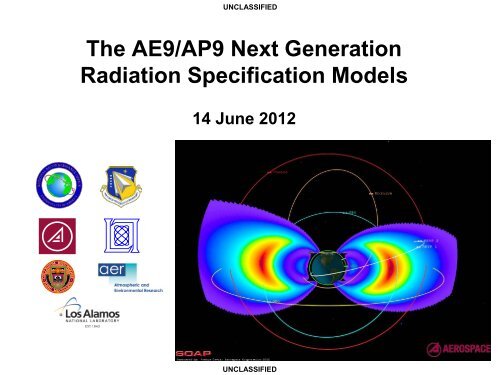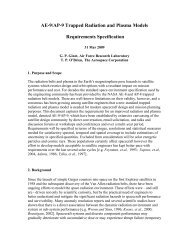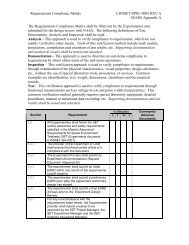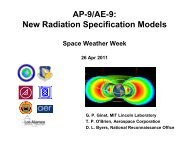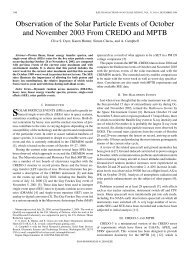The AE9/AP9 Next Generation Radiation Specification ... - SET - NASA
The AE9/AP9 Next Generation Radiation Specification ... - SET - NASA
The AE9/AP9 Next Generation Radiation Specification ... - SET - NASA
You also want an ePaper? Increase the reach of your titles
YUMPU automatically turns print PDFs into web optimized ePapers that Google loves.
UNCLASSIFIED<strong>The</strong> TeamGregory Ginet/MIT-LL, PIgregory.ginet@ll.mit.eduPaul O’Brien/Aerospace, PIpaul.obrien@aero.orgBob Johnston/AFRLafrl.rvborgmailbox@kirtland.af.milTim Guild/AerospaceJoe Mazur/AerospaceStuart Huston/Boston CollegeDan Madden/Boston CollegeRick Quinn/AERChristopher Roth/AERPaul Whelan/AERReiner Friedel/LANLSteve Morley/LANLChad Lindstrom/AFRLRichard Selesnick/AFRLYi-Jiun Caton/AFRLDave Byers/NRO, PMbyersdav@nro.milMichael Starks/AFRL, PMafrl.rvborgmailbox@kirtland.af.milThanks to:James Metcalf/AFRLKara Perry/AFRLSeth Claudepierre/AerospaceBrian Wie/NRO/NGCTim Alsruhe/SCITORClark Groves/USAFInternational Contributors:CNES/ONERA, FranceESA/SRREMS, EuropeJAXA, JapanHope to add more…3UNCLASSIFIED
UNCLASSIFIED20 Jan 2012: <strong>The</strong> First Release of<strong>AE9</strong>/<strong>AP9</strong>• <strong>AE9</strong>/<strong>AP9</strong> is the next generation specification of the natural trapped radiationenvironment near Earth• <strong>The</strong> government developed this new tool with industry, FFRDC, and nationallaboratory partners to improve space system acquisition and survivability• This briefing introduces <strong>AE9</strong>/<strong>AP9</strong> V1.0 and addresses the way forward for V2.0<strong>The</strong> decades-long wait for a new and improved space radiationspecification is now over.4UNCLASSIFIED
•UNCLASSIFIEDEnergetic Particle & Plasma HazardsFalse stars in star tracker CCDsbeforeafterNoenergeticprotonsManyenergeticprotonsSurface degradation from radiationSolar array powerdecrease due toradiation damageElectronics degrade dueto total radiation doseSingle event effects in microelectronics:bit flips, fatal latch-ups1101 ⇒ 0101Solar array arcdischargeSpacecraftcomponentsbecome radioactiveElectromagnetic pulse from vehicle dischargeInducedVoltageTime•UNCLASSIFIED•5
UNCLASSIFIED<strong>The</strong> Need for <strong>AE9</strong>/<strong>AP9</strong>• Prior to <strong>AE9</strong>/<strong>AP9</strong>, the industrystandard models were AE8/AP8which suffered from– inaccuracies and lack of indications ofuncertainty leading to excess margin– no plasma specification with theconsequence of unknown surfacedose– no natural dynamics with theconsequence of no internal chargingor worst case proton single eventeffects environments• AE8/AP8 lacked the ability to tradeactual environmental risks like othersystem risks• AE8/AP8 could never answerquestions such as “how much riskcan be avoided by doubling theshielding mass?”Example: Medium-Earth Orbit (MEO)6System acquisition requires accurate environment specifications withoutunreasonable or unknown margins.UNCLASSIFIED
UNCLASSIFIED<strong>AE9</strong>/<strong>AP9</strong> Use Example:LEO Dipper Concept• A rarely-used mission orbit (150 x1500 km, 83º inclination) requiredan analysis of trades between twohazardous environments:– Perigee dips at ~150 km yield intense atomicoxygen erosion of exposed polymers– Higher apogees expose the vehicle to radiationdose and SEE hazards from the inner Van Allenbelt protons• <strong>AE9</strong>/<strong>AP9</strong> places the mission in thecontext of normal (blue) or extreme(red) radiation environments• <strong>The</strong> <strong>AE9</strong>/<strong>AP9</strong> environment percentiles informed the programof the margin they will have for EEE parts selection<strong>AE9</strong>/<strong>AP9</strong> allows new concepts to trade space environment hazards againstother mission constraints.12UNCLASSIFIED
UNCLASSIFIED<strong>AE9</strong>/<strong>AP9</strong> Limitations• <strong>AE9</strong>/<strong>AP9</strong> has known issues- Protons >100 MeV in the inner zone and SouthAtlantic Anomaly- Electrons < 600 keV in the inner zone and SouthAtlantic Anomaly- Plasma oxygen and electrons have small errorswhich do not adequately reflect the uncertainty in themeasurements• <strong>The</strong> model error bars in some places arefactors of 10 to 100• New data sets will reduce the size ofthese error barsDATA<strong>AE9</strong>Without further improvements to the model, LEO and MEO systems willcontinue to be over-designed13UNCLASSIFIED
UNCLASSIFIED<strong>The</strong> Path to <strong>AE9</strong>/<strong>AP9</strong> V2.0• One major pitfall of AE8/AP8 was the cessation of updates derived from new spaceenvironment data and industry feedback• To insure that <strong>AE9</strong>/<strong>AP9</strong> remains up to date and responsive to program evolution, thefollowing actions must occur in 2012 to 2015:1. Complete full documentation of V1.0 and release underlying database2. Add these industry-requested capabilities: solar cycle dependence of LEO protons; a “sample solarcycle”; local time dependence of plasmas; longitude dependence of LEO electrons3. Ensure ongoing collection of new data to fill holes, improve accuracy, and reduce uncertainty (e.g.<strong>NASA</strong>/RBSP, with emphasis on inner belt protons; AFRL/DSX; TACSAT-4; foreign and domesticenvironment datasets)4. Establish mechanism for annual updates to result in V2 in 2015• NOAA/NGDC has offered to coordinate 5-year updates after 2015– NGDC will host an international collaboration workshop for <strong>AE9</strong>/<strong>AP9</strong> in October 2012RelativisticProtonSpectrometer<strong>NASA</strong> <strong>Radiation</strong> BeltStorm ProbesLaunch August 2012Keeping the model alive will insure that it stays in step with concerns in programacquisition and lessons from space system flight experience.14UNCLASSIFIED
UNCLASSIFIEDHow to Use <strong>AE9</strong>/<strong>AP9</strong>15UNCLASSIFIED
What Type of RunSpec Type Type of Run Duration NotesTotal DoseDisplacement Damage(proton fluence)Perturbed Mean Several orbits ordaysPerturbed Mean Several orbits ordaysSPME+<strong>AE9</strong>,SPMH+<strong>AP9</strong>+Solar<strong>AP9</strong>+SolarProton SEE(proton worst case)Internal Charging(electron worst case)Monte Carlo Full Mission <strong>AP9</strong>+Solar (noSPMH)Monte Carlo Full Mission <strong>AE9</strong> (no SPME)• Run 40 scenarios through either static Perturbed Mean or dynamicMonte Carlo• Compute statistics by comparing results across scenarios (e.g., in whatfraction of scenarios does the design succeed)• Do not include plasma (SPM*) models in worst case runs
UNCLASSIFIEDDo you really need to simulate thewhole mission?GPS, 95% Confidence, Worst Case 24-hour averageHEO, 95% Confidence, Worst Case 24-hour average10 9 Energy, MeVFlux #/cm 2 /s/MeV10 810 710 610 510 410 310 20.5 years1 years2 years3 years4 years5 years6 years7 years8 years9 years10 yearsGPS internalcharging (ElectronFlux) spectrum forvarious missiondurations10 0 10 1Flux #/cm 2 /s/MeV10 810 710 610 510 410 310 20.5 years1 years2 years3 years4 years5 years6 years7 years8 years9 years10 yearsHEO internalcharging (ElectronFlux) spectrum forvarious missiondurations10 0 10 110 9 Energy, MeV• Yes (Space Weather!)• Worst case internal charging flux grows by more than afactor of 2 from a 6 month to a 10 year mission• <strong>The</strong> effect is orbit dependent and even larger in LEO17UNCLASSIFIED
UNCLASSIFIEDTricks for long runs• Select appropriate time step– Altitude < 2000 km @10 seconds (maybe too fine, don’t know yet)– Radius < 2 RE @ 1 minute (1 RE ~ 6378 km)– Radius < 4.5 RE @ 5 minutes– GEO @ 1 hour– Elsewhere @ 15 minutes• Use command line utility• Do 40 scenarios in parallel• Break up long Monte Carlo runs in time by repeating first time point ineach time chunk– E.g., 10 year run, 1/1/2015 to 1/1/2025– Break into 10 1-year orbit files– In each orbit file prepend time/position for 1/1/2015 00:00:00UT– This correctly sets the Monte Carlo epoch to 1/1/2015 00:00:00UT for all time chunks– Will later add epoch keyword– Cannot do this with built-in aggregators (need new utility)18UNCLASSIFIED
UNCLASSIFIEDCaveats• Orbit propagator – Use Kepler (+J2) for long mission sims– Other propagators include orbit physics that is routinely “cancelled out” by maneuvers– Using Kepler or Kepler+J2 implicitly accounts for maneuvers• Plasma-radiation model stitching for integral channels– For integral energy channels that cross the plasma-radiation model boundary, the GUI stitches together themodels– <strong>The</strong> GUI requests “FluxType=2PtDiff” fluxes from the plasma (SPM*) model– <strong>The</strong> GUI requests “FluxType=Integral” fluxes from the radiation (A*9) model– Integral flux (E>X) = [2PtDiff SPM* flux from X to E 0 ]*[E 0 -X] + [Integral A*9 flux >E 0 ]– E 0 is 0.1 MeV for protons, 0.04 MeV for electrons– If you run the console application yourself for integral channels from the plasma model, you will have to do thisstitching yourself, too• Warning – window-averaging aggregators have a startup window issue– For time points before the first full time window, the average can be artificially elevated due to short(disproportionate) residence time in a high radiation region– For example, a GPS orbit that starts in the heart of the outer zone– For the first couple hours, the average-so-far will be very intense and will not reflect typical averages on longertimescales– <strong>The</strong>se aggregators are only present in the C++ -- <strong>The</strong>y are not accessible from the command line utility or the GUIin the current release– In a future release, we will fix the windowing algorithm and provide access via the command line utility19UNCLASSIFIED
UNCLASSIFIEDBug Status• GUI won’t run if SM coordinates are selected for an input ephemeris– <strong>The</strong> GUI creates an input file for the Command Line specifying coordinates as “SM”– <strong>The</strong> Command Line accepts “SSM” not “SM” as a coordinate specification• GUI/command line may not run >~250 Monte Carlo scenarios in a single run– Results from the system’s limit on the number of open files– You can still break up larger numbers of MC scenarios into multiple runs, then aggregate theresults in other software, or change this limit in your system• GUI sometimes crashes when selecting the plot tab before running a scenario– This appears to happen if aborted run files are in the default directory—remove these files• Report bugs and other issues to: Bob Johnston (afrl.rvborgmailbox@kirtland.af.mil)20UNCLASSIFIED
UNCLASSIFIEDPoints of Contact• Comments, questions, etc. are welcome and encouraged!• Please send feedback to (copy all):– Gregory Ginet, MIT Lincoln Laboratory, gregory.ginet@ll.mit.edu– Paul O’Brien, Aerospace Corporation, paul.obrien@aero.org– Bob Johnston, Air Force Research Laboratory, afrl.rvborgmailbox@kirtland.af.mil– Dave Byers, National Reconnaissance Office, byersdav@nro.mil– Michael Starks, Air Force Research Laboratory, afrl.rvborgmailbox@kirtland.af.mil• Information and discussion forum available on <strong>NASA</strong> <strong>SET</strong> website:http://lws-set.gsfc.nasa.gov/radiation_model_user_forum.html• For access to V1.0 code please contact:– Gregory Ginet, MIT Lincoln Laboratory, gregory.ginet@ll.mit.eduDistribution of V1.0 is currently limited to US Government employees and contractors– When cleared for Public Release the code will be made available through the <strong>NASA</strong> <strong>SET</strong> website21UNCLASSIFIED
UNCLASSIFIEDSummary• <strong>AE9</strong>/<strong>AP9</strong> improves upon AE8/AP8 to address modern space systemdesign needs– More coverage in energy, time & location for trapped energetic particles &plasma– Includes estimates of instrument error & space weather statistical fluctuations• Version 1.0 is now available to US Government employees andcontractors– Public Release is imminent• Updates are in the works– Improvements to the user utilities (no change to underlying environments)– Improvements to the model environments (new data)– Additional capabilities (new features, new models)<strong>The</strong> Government-FFRDC team has committed to the ongoing development of the<strong>AE9</strong>/<strong>AP9</strong> models to ensure the continued viability and improved accuracythrough ongoing research and the incorporation of new data sets as part of ourmandate to support the National Security Space community22UNCLASSIFIED


